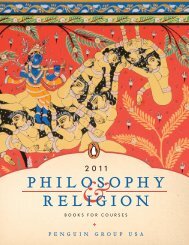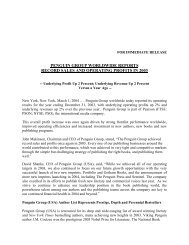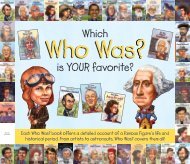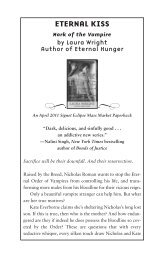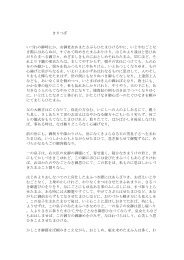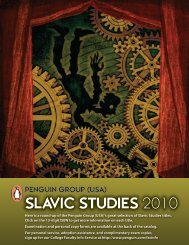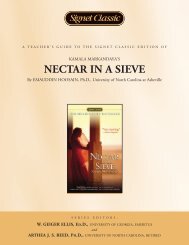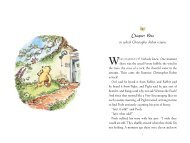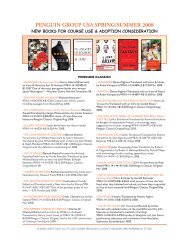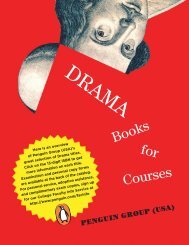Selected Horror Short Stories - Stephen King TG - Penguin Group
Selected Horror Short Stories - Stephen King TG - Penguin Group
Selected Horror Short Stories - Stephen King TG - Penguin Group
You also want an ePaper? Increase the reach of your titles
YUMPU automatically turns print PDFs into web optimized ePapers that Google loves.
s<br />
A TEACHER’S GUIDE TO THE SIGNET EDITIONS OF<br />
SELECTED HORROR SHORT STORIES OF<br />
STEPHEN KING<br />
from the Anthologies Night Shift, Nightmares and Dreamscapes, and Skeleton Crew<br />
Prepared by M. JERRY WEISS, Jersey City State College, Emeritus<br />
SERIES EDITORS:<br />
W. GEIGER ELLIS, ED.D., UNIVERSITY OF GEORGIA, EMERITUS<br />
and<br />
ARTHEA J. S. REED, PH.D., UNIVERSITY OF NORTH CAROLINA, RETIRED
A Teacher’s Guide to <strong>Selected</strong> <strong>Horror</strong> <strong>Short</strong> <strong>Stories</strong> of <strong>Stephen</strong> <strong>King</strong> 2<br />
INTRODUCTION<br />
There is no doubt that <strong>Stephen</strong> <strong>King</strong> is an incredibly popular author of horror short stories and novels. High school students<br />
who have not read his novels have probably seen films based one of them or others for which he has written the screenplays.<br />
Because of his popularity with the young, assigning a <strong>Stephen</strong> <strong>King</strong> short story to a class will certainly appeal to even the<br />
most reluctant readers. Students will read and enjoy his works. Although most teachers recognize the motivational quality<br />
of <strong>King</strong>’s work, many have not considered teaching it in the classroom. His often strong language or the grossness of the<br />
horror in some of his stories may have been a barrier. However, <strong>King</strong> has many stories that are not only motivational, but<br />
worthy of study. Because students are already familiar with <strong>King</strong>’s work and are intrigued by the genre of horror, they are<br />
willing to analyze the stories and use them as a model for their own writing. When introduced as the first readings in a unit<br />
on horror and suspense in literature, <strong>King</strong>’s short stories can be excellent springboards to the work of the classic novelists.<br />
The goal of this teacher’s guide is to provide a selection of <strong>King</strong>’s short stories that are appropriate for classroom use.<br />
Without a doubt they are horrifying; however, they also have important messages about good and evil and human motivation.<br />
The vocabulary in the selected stories is frequently challenging, but rarely crude. When hard colloquial language<br />
is employed, it is appropriate to the characters and the story. Teachers, however, are warned to pre-read these stories before<br />
assigning them to a class, and to use only those that are most appropriate for the maturity of the students.<br />
This teacher’s guide will suggest ways to incorporate the selected <strong>Stephen</strong> <strong>King</strong> short stories into the high school or college<br />
English curriculum. It is divided into the following sections: Introduction, Overview of <strong>Stephen</strong> <strong>King</strong> and His Work,<br />
Suggestions for Teaching, Extending Students’ Knowledge, and A Note About Censorship. The activities suggested require the<br />
students’ active involvement in the stories and include ideas for discussion, writing, research, drama, and utilization of technology.<br />
WHAT MAKES STEPHEN KING’S FICTION WORTHY OF STUDY?<br />
Recent surveys of high school and college students indicate that the fiction of <strong>Stephen</strong> <strong>King</strong> is highly read. In terms of<br />
popularity, he is a major contemporary author who has mastered the craft of creating horror and suspense stories, both<br />
genres with long historic and literary roots. Such writers as Charlotte Bronte, Emily Bronte, Mary Shelley, Bram Stoker,<br />
William Shakespeare, Edgar Allan Poe, Nathaniel Hawthorne, Herman Melville, Robert Louis Stevenson, Wilkie Collins,<br />
and Charles Dickens are just a few examples of classic writers who won similar popular acclaim in their day.<br />
1. <strong>Stephen</strong> <strong>King</strong> is, first and foremost, a good storyteller.<br />
2. He uses terror, horror, and “gross” techniques to captivate his readers.<br />
3. He cleverly creates the unexpected.<br />
4. Youthful and elderly characters are important in his stories.<br />
5. He provides insights into the dark side of humanity.<br />
6. The forces of good and evil are often equal combatants.<br />
7. The fragility of life is a major theme.<br />
8. He writes about “taboo subjects” such as death, destruction, and the unknown.<br />
9. Characters often harbor evil and/or vengeful feelings that compel their actions.<br />
10. He is not a moralist; his stories unfold naturally.
A Teacher’s Guide to <strong>Selected</strong> <strong>Horror</strong> <strong>Short</strong> <strong>Stories</strong> of <strong>Stephen</strong> <strong>King</strong> 3<br />
OVERVIEW OF STEPHEN KING AND HIS WORK<br />
<strong>Stephen</strong> <strong>King</strong> was born in Portland, Maine, in September 1947. His father left the family while <strong>Stephen</strong> was very young,<br />
and his mother supported them with a variety of low-paying jobs. After moving several times, the family moved to<br />
Durham, Maine, where <strong>Stephen</strong>’s mother took care of her aging parents.<br />
Although <strong>Stephen</strong>’s father was not a part of his life, he influenced him by leaving behind many fantasy-horror fiction<br />
books. A lonely child who wore thick glasses and was not good in athletics, <strong>Stephen</strong> preferred the solitary activities of listening<br />
to horror stories on the radio, reading scary books, and watching science fiction movies. As a youth, <strong>Stephen</strong> read<br />
avidly and enjoyed a wide variety of books by authors such as John D. MacDonald, Ed McBain, Shirley Jackson, J. R. R.<br />
Tolkien, Ken Kesey, Margaret Mitchell, Andre North, Jack London, Agatha Christie, and Thomas Hardy.<br />
By the time <strong>Stephen</strong> was in high school, he was writing short stories modeled on the books he had read. They were set in<br />
small towns and included horror and suspense. He began sending them to science fiction magazines, and although none<br />
were published, he did win first prize in an essay contest. He was also developing other interests and becoming more social.<br />
He played football and the guitar with a rock-and-roll band. After graduating from high school, he received a scholarship<br />
to major in English at the University of Maine at Orono. While in college he had to work several part-time jobs to support<br />
himself. In 1971 he married Tabitha Jane Spruce whom he had met at the University and remains married to today.<br />
By the time <strong>Stephen</strong> graduated from college, he had published two short stories for which he received a total of $70.<br />
However, he could not support himself and Tabitha by writing, and he continued to work at one of his part-time jobs.<br />
Finally, he found a job teaching English at Hampden Academy, a private co-ed secondary school. Whenever he could find<br />
time, he wrote fiction. Periodically, he would sell a short story to a magazine; however, the young couple barely had<br />
enough money for food and other bills.<br />
Discouraged, he threw away a book manuscript. Tabitha, always supportive of his writing, retrieved it and urged him to send<br />
it to an editor at Doubleday who had shown some interest in his efforts. Sure enough, Doubleday decided to publish his<br />
first novel, Carrie, and the novel’s paperback rights were sold for $400,000. <strong>Horror</strong> readers loved it, and his career was<br />
born. In 1976, Brian De Palma turned the novel into a financially successful movie. A paperback tie-in was released along<br />
with the film and over four-million copies were sold. <strong>Stephen</strong> was able to stop teaching and devote full time to writing.<br />
Soon after, <strong>Stephen</strong> signed a multimillion dollar contract with New American Library, who still publish his paperbacks, and<br />
since the publication of The Dead Zone in 1979, Viking has published his new hardcover books. Today, <strong>Stephen</strong> <strong>King</strong>’s novels<br />
and short story anthologies have been turned into popular films. While each new book rises to the top of the best-seller charts<br />
he, Tabitha, and their three children continue to live modestly in Maine. The <strong>King</strong> family is very close and talk about the kinds<br />
of things many families discuss: little league, books, and movies. The <strong>King</strong>s, although famous, lead a normal life. <strong>Stephen</strong><br />
<strong>King</strong> admits to having many fears, but he also has many interests and still enjoys reading, radio, and rock-and-roll.
A Teacher’s Guide to <strong>Selected</strong> <strong>Horror</strong> <strong>Short</strong> <strong>Stories</strong> of <strong>Stephen</strong> <strong>King</strong> 4<br />
IN HIS OWN WORDS<br />
<strong>Stephen</strong> <strong>King</strong> has been interviewed by many people. As a best-selling author and master craftsman of tales of horror, he<br />
frequently appears in the popular press and media. Through <strong>King</strong>’s own words, students can get a good picture of the man<br />
and the writer. Teachers can use <strong>King</strong>’s remarks to encourage discussions about writing and his stories. <strong>King</strong>’s comments<br />
have been grouped by topic for easy reference and discussion.<br />
READERS AND READING<br />
“<strong>Horror</strong> fiction was conservative and that was its appeal to teenagers—the two things go together because teenagers are<br />
the most conservative people in American society. You know, small children take is as a matter of course that things will<br />
change every day and grown-ups understand that things change sooner or later and their job is to keep them from changing<br />
as long as possible. It’s only kids in high school who are convinced they’re never going to change.”<br />
From “An Evening with <strong>Stephen</strong> <strong>King</strong> at the Billerica Massachusetts Public Library,” 1983. (© by Colony<br />
Communications, Inc.)<br />
“I think you can do more with creative writing in high school than you can in college.... the thing about high school is<br />
that the students look at school in a different way.”<br />
“I had my college students read Double Indemnity by James M. Cain...and I had them read a novel by David Morrell called<br />
First Blood.... I had them read primarily novels...and I wanted them to read, to think, and to write about what they had read.”<br />
From “An Interview with <strong>Stephen</strong> <strong>King</strong>” by Paul Janeczko. Published in English Journal, February 1980. (©<br />
1980 by the Nation Council of Teachers of English.)<br />
“I can’t think of half a dozen movies that would compare with the books that spawned them.”<br />
From “Interview with <strong>Stephen</strong> <strong>King</strong>” by Michael Kilgore, Published in the Tampa Tribune, August 31, 1986 (©<br />
1986 Michael Kilgore.)<br />
“The horror story makes us children, OK? That’s the primary function of the horror story—to knock away all of this<br />
stuff...we cover ourselves up with. <strong>Horror</strong> is seen as this barren thing that’s supposed to take us over taboo lines, to places<br />
we aren’t supposed to be.... And children are able to feel things adults can’t, because of all the experience we’ve had.”<br />
FEARS<br />
From “The Dark Beyond the Door: Walking (Nervously) into <strong>Stephen</strong> <strong>King</strong>’s World” by Freff. Interview originally<br />
published in Tomb of Dracula, Issues No. 4 and 5. (© 1980 Marvel Comics <strong>Group</strong>.)<br />
“People ask what scares me. Everything scares me. Bugs are bad.... Sometimes I think about taking a bite into a great big<br />
hoagie, you know...full of bugs.... Getting stuck in elevators.... Airplanes. The dark is a big one. I don’t like the dark....<br />
Just about everything frightens me.”<br />
From “An Evening with <strong>Stephen</strong> <strong>King</strong> at the Billerica Massachusetts Public Library,” 1983. (© by Colony<br />
Communications, Inc.)<br />
“I don’t walk under ladders; I’m scared...I’ll get seven years’ bad luck if I break a mirror; I try to stay home cowering under<br />
the covers on Friday the thirteenth.... But I have a thing about the number 13 in general; it never fails to trace that old<br />
icy finger up and down my spine.”<br />
From “Playboy Interview: <strong>Stephen</strong> <strong>King</strong>,” June 1983. (© 1983 by Playboy.)
A Teacher’s Guide to <strong>Selected</strong> <strong>Horror</strong> <strong>Short</strong> <strong>Stories</strong> of <strong>Stephen</strong> <strong>King</strong> 5<br />
EVIL AND HORROR<br />
“The [horror] genre exists on three basic levels, separate but independent, and each one a little bit cruder than the one<br />
before. There’s terror on top, the finest emotion any writer can induce; then horror and on the very lowest level of all, the<br />
gag instinct of revulsion. Naturally, I’ll try to terrify you first, and if that doesn't work, I’ll try to horrify you, and if I can’t<br />
make it there, I’ll try to gross you out.”<br />
From “Playboy Interview: <strong>Stephen</strong> <strong>King</strong>,” June 1983. (© 1983 by Playboy.)<br />
“A lot of people retreat into fantasy worlds because the real world is kind of a gruesome place.<br />
“I think most people see horror writers as depraved individuals who are strange, weird, a little bit creepy, probably unlovely,<br />
somebody who would be clammy to touch.<br />
“Most of the ones [horror writers] I know are big, hale and hearty, cheerful, outgoing, friendly people, and I think one of<br />
the reasons they are is that you have to have a certain confidence in yourself to be able to create a human monster.”<br />
From “Would You Buy a Haunted Car From This Man?” by Edwin Pouncey. Published in Sounds magazine,<br />
May 21, 1983. (© by Spotlights Publications Ltd.)<br />
“Nobody in this field talks about good. Everybody talks about evil. Evil is a tremendously attractive force—a tremendously<br />
potent force. You’ve got more and more books where evil wins, where evil proves to be the stronger. Rosemary’s Baby<br />
is one. And even in The Exorcist it’s very hard to tell what happens in the end.”<br />
From “Shine of the Times,” an interview with <strong>Stephen</strong> <strong>King</strong> by Marty Ketchum, Pat Cadigan, and Lewis Shiner.<br />
Published in Shayol, Summer 1979, Volume One, Number Three. (© 1979 by Flight Unlimited, Inc.)<br />
“<strong>Horror</strong> is one of the ways we walk our imagination. It’s a way to relieve bad feelings rather than something that causes them.”<br />
WRITING<br />
From “Novelist Loves His Nightmares” by Jack Matthews. Published in Detroit Free Press, November 12, 1982.<br />
(© 1982 by Detroit Free Press.)<br />
“Writing is necessary for my sanity. As a writer I can externalize my fears and insecurities and night terrors on paper....<br />
And in the process, I’m able to write myself sane.<br />
“Those avatars of high culture hold it almost as an article of religious faith that plot and story must be subordinated to<br />
style, whereas my deeply held conviction is that story must be paramount.... All other considerations are secondary—<br />
theme, mood, even characterization and language.”<br />
From “Playboy Interview: <strong>Stephen</strong> <strong>King</strong>,” June 1983. (© 1983 by Playboy)<br />
“I would say plotting is the most difficult thing. Characterization is only hard because sometimes I feel I get so interested<br />
in it that I want to talk too much about the characters and that slows the story down.<br />
“I start with ideas and I know where I’m going but I don’t outline. I usually have an idea of what’s going to happen...but<br />
I never write any of it down because that sort of closes you off from an interesting sidetrip that might come along.”<br />
From “An Interview with <strong>Stephen</strong> <strong>King</strong>” by Joyce Lynch Dewes Moore. Published in Mystery magazine, March<br />
1981. (© 1980 by Joyce Lynch Dewes.)<br />
“A writer learns by reading: how important motivation is to the story.”<br />
From “An Interview with <strong>Stephen</strong> <strong>King</strong>,” by Paul Janeczko. Published in English Journal, February 1980. (©<br />
1980 by the National Council of Teachers of English.)
A Teacher’s Guide to <strong>Selected</strong> <strong>Horror</strong> <strong>Short</strong> <strong>Stories</strong> of <strong>Stephen</strong> <strong>King</strong> 6<br />
SUGGESTIONS FOR TEACHING<br />
BEFORE READING THE STORIES<br />
• Introduce the genre of horror and suspense with a film, such as The Haunting, The Phantom of the Opera, or Psycho. Have<br />
students identify and analyze the elements of suspense and horror in the film.<br />
• Orally read a horror story, such as Edgar Allan Poe’s “The Tell-Tale Heart” to the class. Discuss why it is so horrifying.<br />
• Compile a collection of horror and/or suspense stories with which the students are familiar.<br />
DURING READING ACTIVITIES<br />
• As an introduction to a unit on horror and suspense, small groups of students can each read a different <strong>Stephen</strong> <strong>King</strong><br />
selected short story, and discuss and write about the stories using the question and activities below. After reading, discussing,<br />
and writing about the <strong>King</strong> stories, students can read one of more of the classic works suggested in the bibliography.<br />
Students can utilize their knowledge of the genres of horror and suspense learned from reading the <strong>King</strong> stories to<br />
analyze the classic fiction.<br />
• Students can keep a response journal, recording their reactions to the stories. They can select their own topics or respond<br />
to the questions below.<br />
• The response journal might be followed up with students working in reading groups. Students who have read the same<br />
story can share their ideas and, thereby gain other insights into the story.<br />
• These questions are appropriate to discuss or write about after reading any of the suggested short stories:<br />
What is the nature of evil?<br />
What is the embodiment of evil in the story?<br />
How does <strong>King</strong> develop the suspense in the story?<br />
What elements of surprise are built into the story?<br />
Who is the protagonist? Is she or he a victim? How does <strong>King</strong> make you empathize with the protagonist?<br />
Who or what is the antagonist? When do you discover who the antagonist is? How do you feel after you discover<br />
this?<br />
QUESTIONS AND ACTIVITIES FOR SUGGESTED SHORT STORIES<br />
Each of the selected short stories listed below are appropriate for classroom use, and the questions and activities are<br />
designed for the indicated short story. The questions should allow students to respond to the stories orally or in writing.<br />
They may be used with the entire class or with small groups of students. Teachers may find other stories in the three<br />
anthologies that are appropriate for their particular students.<br />
STORIES FROM NIGHT SHIFT<br />
“JERUSALEM’S LOT”<br />
1. As a writing technique <strong>King</strong> uses a series of letters to explain what is happening in Chapelwaite. How effective is this technique<br />
as he spins his haunting tale?<br />
2. The eerie setting is established early in the story. Describe your reaction to Calvin’s comments about townspeople stating:<br />
“What was said, sir, was that anyone who would live in Chapelwaite must be either a lunatic or run the risk of becoming one.”<br />
3. What does Charles learn about his ancestry from Mrs. Cloris? What does Charles learn about the house?
A Teacher’s Guide to <strong>Selected</strong> <strong>Horror</strong> <strong>Short</strong> <strong>Stories</strong> of <strong>Stephen</strong> <strong>King</strong> 7<br />
4. Explain Mrs. Cloris’s statement, “Some die not...some live in the twilight shadows between to serve—Him!”<br />
5. Why do you think <strong>King</strong> tries to involve all of one’s senses in describing Jerusalem’s Lot? How effective is he?<br />
6. Charles states that he thinks he knows why “Jerusalem’s Lot is a shunned town.” What reasons can you give for this plausible<br />
conclusion?<br />
7. What is a “Satan’s Mass”?<br />
8. How does Mrs. Cloris explain the evil things that have happened since Charles and Calvin have arrived? What does she<br />
recommend? If you were in their places, would you leave? Explain. What history about Chapelwaite does she offer?<br />
9. <strong>King</strong> wants to increase the sense of horror as Charles and Calvin explore the house. What do they discover in the cellar?<br />
10. What is meant by “nosferatu—the Undead”?<br />
11. What does Calvin seem to indicate when he writes: “It seems we wait in the deceptive Eye of the Storm”?<br />
12. What evidence is there that “blood calls to blood”? What does this mean?<br />
13. Describe the horror that takes place when Calvin and Charles return to the church.<br />
14. What part does James Boon play in “Jerusalem’s Lot”?<br />
15. How does <strong>King</strong> conclude this tale? What twists are added to the tale? What do you think might happen?<br />
“GRAVEYARD SHIFT”<br />
1. In tens words of less, describe Hall at the beginning of the story.<br />
2. What element of horror does <strong>King</strong> use to introduce this tale?<br />
3. <strong>King</strong> skillfully establishes the setting and action for the tale. If you were Hall, would you accept the job offer? Explain<br />
your answer.<br />
4. What do you think Hall’s premonition is that involves Warwick?<br />
5. How does <strong>King</strong> appeal to all of the reader’s senses as he describes the setting and circumstances? How effective is the<br />
author?<br />
6. Wisconsky describes the rats, “It almost seems like they think. You ever wonder how it’d be, if we was little and they were<br />
big?” To what extent does this enable the reader to foresee the structure of the action within the story?<br />
7. What horrible thing happened to Ray Upton? What is the reaction among the workers?<br />
8. As the story develops, what is the relationship between Hall and Warwick? How does Hall confront Warwick with town<br />
ordinances? What is the effect?<br />
9. What do the men discover in the sub-cellar?<br />
10. How does <strong>King</strong> skillfully end the story? What is your reaction to his technique?<br />
“NIGHT SURF”<br />
1. What seems to bond the young people together? What are your feelings about these people?<br />
2. What is “A6”? Compare it to similar diseases throughout history.<br />
3. How do you explain the Bernie-Susie relationship?<br />
4. What has changed since “A6”?<br />
5. What would be your thoughts and activities if you and five friends were the last inhabitants on earth?
A Teacher’s Guide to <strong>Selected</strong> <strong>Horror</strong> <strong>Short</strong> <strong>Stories</strong> of <strong>Stephen</strong> <strong>King</strong> 8<br />
“I AM THE DOORWAY”<br />
1. What in your mind, are the achievements as a result of space flights? What is the cost of a space flight program? What are<br />
your personal feelings about maintaining such a program? What tragedies and near tragedies have taken place over the<br />
years of the U.S. space flight programs?<br />
2. What happened to Arthur as he came down from his space flight? How has this affected him? What was the shocking discovery<br />
he made about his itchings?<br />
3. What does Arthur mean when he says, “I am the doorway”?<br />
4. What leads Arthur to his final decision?<br />
“GRAY MATTER”<br />
1. What is the setting for this story? Why is it so important?<br />
2. How does Henry react to Timmy’s plea?<br />
3. What is the horrible tale Henry tells the others as they are carrying the beer to Richie’s? What are their reactions? What<br />
are yours?<br />
4. How do you explain the end of the story?<br />
5. How does <strong>King</strong> draw the reader’s senses into this grotesque tale?<br />
“STRAWBERRY SPRING”<br />
1. What is “strawberry spring”? How does this become a part of the story?<br />
2. Listen to a recording of “Love is Blue” or “Hey, Jude” or “Scarborough Fair” to get a sense of the times—the late 1960s.<br />
Also, note that <strong>Stephen</strong> <strong>King</strong> is an avid radio and rock-and-roll fan.<br />
3. Who is “Springheel Jack”?<br />
4. Research information about Jack the Ripper.<br />
5. Near the end of the story, <strong>King</strong> has a paragraph that refers to “draft protesters,” a “sit-in where a well-known napalm manufacturer<br />
was holding interviews.” Find information about the late 1960s in newspapers and magazines to see how common<br />
such situations were. Why did people feel this way? Could such activities happen today? Explain.<br />
6. What is your reaction to the ending of the story?<br />
“THE LAST RUNG ON THE LADDER”<br />
1. <strong>King</strong> enjoys using children in his stories. How does he capitalize on their secrets and curiosities in this tale?<br />
2. How effective is the transition from the results of jumping into the hay to the news item Larry has about his sister?<br />
3. Why did the contents of the letter move Larry?<br />
4. What are your feelings about Larry?<br />
“THE MAN WHO LOVED FLOWERS”<br />
1. How would you best describe the young man? If you were in a position to make a television program based on the story,<br />
what actor could play this part? What criteria did you use to make this decision?<br />
2. How do the radio news items contrast with the season and the young man’s feelings?<br />
3. What was meant by the statement, “His name was love”?
A Teacher’s Guide to <strong>Selected</strong> <strong>Horror</strong> <strong>Short</strong> <strong>Stories</strong> of <strong>Stephen</strong> <strong>King</strong> 9<br />
“THE WOMAN IN THE ROOM”<br />
1. Why is the man who is visiting his mother in the hospital upset by the thought of the “cortotomy”?<br />
2. Find out as much as you can about Michael Crichton’s The Terminal Man and Ken Kesey’s One Flew Over the Cuckoo’s<br />
Nest. How do these works inform <strong>King</strong>’s story?<br />
3. <strong>King</strong> makes an unusual comparison as he describes patients walking slowly in the hospital hall. “It is the walk of people<br />
who are going nowhere slowly, the walk of college students in caps and gowns filing into a convocation hall.” What is<br />
your reaction to this comparison?<br />
4. The doctor says, “Your mother can no longer count time in terms of seconds and minutes and hours. She must restructure<br />
those units into days and weeks and months.” What do you think he means?<br />
5. What is your reaction to what Johnny does to help his mother out of her condition? Do you think mercy killing is ever<br />
justified? Explain.<br />
STORIES FROM NIGHTMARES AND DREAMSCAPES<br />
“SUFFER THE LITTLE CHILDREN”<br />
1. Why do you think Miss Sidley picks on her students?<br />
2. How might you explain how she seems to know what her students are thinking or doing?<br />
3. Why is Robert her major nemesis?<br />
4. What does Robert mean when he says, “There’s quite a few of us”?<br />
5. Why does Miss Sidley bring a gun to school? Do you think she was justified in using it? Explain your response.<br />
6. How would you explain the ending of the story?<br />
“THE DOCTOR’S CASE”<br />
1. Explain the title of this story.<br />
2. What is meant by “I might as well set it down before God caps my pen forever”?<br />
3. Identify Lestrade, Watson, and Holmes.<br />
4. Why does Lestrade bring Holmes into the case?<br />
5. Who solves the murder? How?<br />
6. Compare this story with a Sherlock Holmes mystery by Arthur Conan Doyle and note the differences in the characters<br />
of Dr. Watson and Holmes.<br />
STORIES FROM SKELETON CREW<br />
“WORD PROCESSOR OF THE GODS”<br />
1. What did the title suggest to you before you read the story?<br />
2. Describe the word processor Jon created. Why did he build it?<br />
3. Would you prefer Jon or Seth as a friend? Give your reasons.<br />
4. The Jon we meet at the end of the story is somewhat different from the Jon at the beginning. Discuss how he has changed<br />
and what events have made him different.
A Teacher’s Guide to <strong>Selected</strong> <strong>Horror</strong> <strong>Short</strong> <strong>Stories</strong> of <strong>Stephen</strong> <strong>King</strong> 10<br />
5. What is Nordhoff’s role in this story?<br />
6. Can you justify Richard using the EXECUTE button the way he did? Explain your answer.<br />
“THE MAN WHO WOULD NOT SHAKE HANDS”<br />
1. How does the author build suspense in this story?<br />
2. What is meant by “IT IS THE TALE, NOT HE WHO TELLS IT”?<br />
3. Who are George Gregson’s fifty-three “good friends who saw me through my time of trial”? How is this an example of<br />
the use of irony?<br />
4. What events lead to Brower never shaking hands? How does George learn of these events?<br />
5. Compare this story with <strong>King</strong>’s novella, “The Breathing Method” in Different Seasons.<br />
“THE REAPER’S IMAGE”<br />
1. Who is the reaper in this story? Where is he seen?<br />
2. What kind of place is the Samuel Claggert Memorial Private Museum?<br />
3. Describe the characteristics of Mr. Carlin and Johnson Spangler. What kind of person is each one?<br />
4. What does the author tell us about Delver Mirrors?<br />
5. Do you like the ending? Give your reasons. Continue the story with an additional episode.<br />
“UNCLE OTTO’S TRUCK”<br />
1. <strong>King</strong> cautions readers, “Most of you... will not believe.” How does he make this a believable story?<br />
2. The author compares the final break-down of Uncle Otto’s truck with the “wonderful one-Hoss shay” in Oliver Wendell<br />
Holmes’ poem “The Deacon’s Masterpiece.” Based on that poem, write your won description of the truck’s demise.<br />
3. What observations led to the narrator’s suspicion that Uncle Otto murdered his partner? How? Why?<br />
4. Give some examples of how <strong>King</strong> uses humor in this tale.<br />
AFTER READING ACTIVITIES<br />
DRAMA<br />
• Have a small group of students develop a classroom dramatic presentation of one of the stories for the class.<br />
• Sponsor a <strong>Stephen</strong> <strong>King</strong> Storytelling Festival. Students can sign up to tell their favorite tale. This can be either a group<br />
project where several participate in telling a story, or an individual project. The emphasis is on oral interpretation and<br />
making the story come alive. Adaptations are permissible.<br />
• Do a class “campfire” in which each small group of students tells their story utilizing good storytelling techniques.<br />
Students should orally capture their listeners’ attention as <strong>King</strong> captures his readers’ attention.<br />
MEDIA<br />
• “Inner Sanctum” was a popular radio program. Several cassette recordings have been made and are commercially available.<br />
Play one or two of these and compare them with the <strong>King</strong> stories you have read. Adapt one <strong>King</strong> story for a similar<br />
radio program. Present the adaptation via the school public address system or make a recording for use in another class.
A Teacher’s Guide to <strong>Selected</strong> <strong>Horror</strong> <strong>Short</strong> <strong>Stories</strong> of <strong>Stephen</strong> <strong>King</strong> 11<br />
• View one or two “Twilight Zone” videotapes. How well do you think <strong>Stephen</strong> <strong>King</strong>’s short stories could be adapted for<br />
this series? Try choosing one story and make a film/videotape or screen adaptation.<br />
• Several of <strong>Stephen</strong> king’s novels have been made into movies. Choose from the following list and make a comparison between<br />
the book and film versions: Carrie, Misery, The Shining, Dolores Claiborne, The Shawshank Redemption (based on “Rita Hayworth<br />
and the Shawshank Redemption” in Different Seasons), or Stand By Me (based on “The Body” in Different Seasons).<br />
WRITING<br />
• Encourage students to write their own horror stories. By using a copy machine or computer, publish a story collection.<br />
Some students might serve as editors and illustrators. This would be a great Halloween project.<br />
• Using one or more of <strong>King</strong>’s short stories as models, write a horror story in which suspense builds and there is an element<br />
of surprise.<br />
• Write a first paragraph for a suspense/horror story that captures the readers’ attention in the way <strong>King</strong> does.<br />
• Setting the scene is important in horror and suspense. Discuss <strong>King</strong>’s settings and develop one of your own for a horror<br />
or suspense story.<br />
READING<br />
• Read what <strong>Stephen</strong> <strong>King</strong> has written about evil and analyze the story you have read applying his comments.<br />
• Compare <strong>King</strong>’s plots to the plot of any other horror or suspense story you have read. Discuss why <strong>King</strong> is such a popular<br />
writer.<br />
TECHNOLOGY<br />
• There are several electronic newsgroups for fans of <strong>Stephen</strong> <strong>King</strong>. Have students monitor a group and then post a question<br />
or new topic for discussion. Many <strong>Stephen</strong> <strong>King</strong> homepages can be found on the internet.<br />
EXTENDING STUDENTS’ LEARNING<br />
ACTIVITIES<br />
• Have students write a critical review of one of <strong>King</strong>’s short stories. Discuss how the author builds the suspense and introduces<br />
the horror. Examine how he deals with evil, captures the readers’ attention, and utilizes elements of surprise. Submit<br />
your review to the school literary journal or newspaper.<br />
• Read about the lives of other horror or suspense writers. Compare their fears to the fears <strong>King</strong> writes about.<br />
• Read what <strong>King</strong> says about writing. Read other authors’ comments on writing. What similarities and differences do you find?
A Teacher’s Guide to <strong>Selected</strong> <strong>Horror</strong> <strong>Short</strong> <strong>Stories</strong> of <strong>Stephen</strong> <strong>King</strong> 12<br />
BIBLIOGRAPHY<br />
SUGGESTIONS FOR ADDITIONAL READING<br />
Bronte, Charlotte. Jane Eyre, New York: Signet Classic, 1960. Afterword by Arthur Zeiger.<br />
Bronte, Emily. Wuthering Heights. New York: Signet Classic, 1957. Introduction by Susan Fromberg Schaeffer.<br />
Collins, Wilkie. The Woman in White. New York: Signet Classic, 1985. Introduction by Frederick R. Karl.<br />
Conrad, Joseph. Heart of Darkness and The Secret Sharer. New York: Signet Classic, 1983. Introduction by Albert I. Guerard.<br />
Conrad, Joseph. Tales of Unrest. New York: <strong>Penguin</strong> Classic, 1991.<br />
Cuddon, J.A., ed. The <strong>Penguin</strong> Book of Ghost <strong>Stories</strong>. New York: <strong>Penguin</strong>, 1984.<br />
Cuddon, J.A., ed. The <strong>Penguin</strong> Book of <strong>Horror</strong> <strong>Stories</strong>. New York: <strong>Penguin</strong>, 1984.<br />
Dickens, Charles. <strong>Selected</strong> <strong>Short</strong> Fiction. New York: <strong>Penguin</strong> Classic, 1976. Introduction by Deborah A. Thomas.<br />
Doyle, Sir Arthur Conan. The Adventures of Sherlock Holmes. New York: <strong>Penguin</strong>, 1981.<br />
Doyle, Sir Arthur Conan. The Sherlock Holmes Mysteries. New York: Signet Classic, 1987. Introduction by Frederick Busch.<br />
Hardy, Thomas. The Distracted Preacher and Other Tales. New York: <strong>Penguin</strong> Classic, 1979. Introduction by Susan Hill.<br />
Hardy, Thomas. Jude the Obscure. New York: Signet Classic, 1980. Afterword by A. Alvarez.<br />
Hawthorne, Nathaniel. <strong>Selected</strong> Tales and Sketches. New York: <strong>Penguin</strong> Classic, 1987. Introduction by Michael J. Colacurcio.<br />
Jackson, Shirley. The Haunting of Hill House. New York: <strong>Penguin</strong>, 1984.<br />
Jackson, Shirley. We Have Always Lived in the Castle. New York. <strong>Penguin</strong>, 1984.<br />
James, Henry. The Turn of the Screw and Other <strong>Short</strong> Novels. New York: Signet Classic, 1995. Introduction by Perry Meisel.<br />
Kafka, Franz. The Transformation (“Metamorphosis”) and Other <strong>Stories</strong>. New York: <strong>Penguin</strong> Classic, 1992. Edited and<br />
Translated by Malcolm Pasley.<br />
Kaye, Marvin, ed. The <strong>Penguin</strong> Book of Witches and Warlocks: Tales of Black Magic, Old and New. New York: <strong>Penguin</strong>, 1991.<br />
Poe, Edgar Allan. The Portable Poe. New York: <strong>Penguin</strong>, 1977. Edited by Philip Van Doren Stern.<br />
Poe, Edgar Allan. The Science Fiction of Edgar Allan Poe. New York: <strong>Penguin</strong> Classic, 1976. Introduction by Harold Beaver.<br />
Ryan, Alan, ed. The <strong>Penguin</strong> Book of Vampire <strong>Stories</strong>. New York: <strong>Penguin</strong>, 1988.<br />
Shelley, Mary. Frankenstein. New York: Signet Classic, 1963. Afterword by Harold Bloom.<br />
Skal, David J. The Monster Show: A Cultural History of <strong>Horror</strong>. New York: <strong>Penguin</strong>, 1994.<br />
Stevenson, Robert Louis. Dr. Jekyll and Mr. Hyde. New York: Signet Classic, 1987. Introduction by Vladimir Nabokov.<br />
Stoker, Bram. Dracula. New York: Signet Classic, 1965. Introduction by Leonard Wolf.<br />
Wells, H. G. <strong>Selected</strong> <strong>Short</strong> <strong>Stories</strong>. New York: <strong>Penguin</strong> Classic, 1979.<br />
Wilde, Oscar. The Picture of Dorian Gray and <strong>Selected</strong> <strong>Stories</strong>. New York: Signet Classic, 1962. Foreword by Gary Schmidgall.<br />
Winter, Douglas E. <strong>Stephen</strong> <strong>King</strong>: The Art of Darkness. New York: Signet, 1986.<br />
Woolrich, Cornell. Rear Window and Other <strong>Stories</strong>. New York: <strong>Penguin</strong>, 1994.<br />
Woolrich, Cornell. Waltz Into Darkness. New York: <strong>Penguin</strong>, 1995.
A Teacher’s Guide to <strong>Selected</strong> <strong>Horror</strong> <strong>Short</strong> <strong>Stories</strong> of <strong>Stephen</strong> <strong>King</strong> 13<br />
A NOTE ABOUT CENSORSHIP<br />
In spite of the quality of <strong>Stephen</strong> <strong>King</strong>’s short stories, teachers have been reluctant to use them in the classroom because<br />
of his notoriety as a horror writer. <strong>Horror</strong>, even when considered classic, is often the target of censorship. For this teachers’<br />
guide, we have selected stories for their quality and appropriateness for classroom use. However, it is important for<br />
teachers to carefully read each of the stories selected and be sure that they fit the goals of the English program and will<br />
benefit the students who read them.<br />
The best way to deal with censorship is to avoid it. Here are some suggestions:<br />
1. Develop a department or school selection policy in which you clearly indicate criteria for selecting literature to be read,<br />
as well as a procedure for dealing with complaints should they occur.<br />
2. Once the policy has been established, involve as many people in the selection process as possible. Include teachers, administrators,<br />
students, and parents on your selection committee.<br />
3. Write a brief rationale for using <strong>Stephen</strong> <strong>King</strong>’s short stories in the classroom. Emphasize their literary quality, their appropriateness<br />
in meeting the goals and objectives of the English program, their appropriateness for the maturity and ability<br />
of the students being taught, and their ability to motivate students to read and to write. Include comments from this<br />
teachers’ guide and any other critical comments about <strong>Stephen</strong> <strong>King</strong>’s short stories. File this rationale with your department<br />
chairperson and/or school administrator.<br />
4. Several weeks prior to requiring students to read the short stories, send home brief descriptions to parents or guardians.<br />
Be sure to include parts of your rationale and the fact that some of the language and/or content may be found objectionable<br />
by some people. Invite parents to borrow copies of the short stories to read prior to giving their children permission<br />
to read them. Be sure to indicate alternative selections for students who are not permitted to read them (i.e. short<br />
stories by Poe or Hawthorne).<br />
5. A week prior to reading the short stories in class send permission slips home for parents to complete. Phrase the slips in<br />
such a way that signing them and returning them indicates that permission has not been granted. Ask parents to suggest<br />
a preferred short story of equal literary and motivational value if they know one.<br />
6. Be sure to make adequate provisions, avoiding stigmatization, for students who are not permitted to read the short stories.<br />
This may mean having to work individually with one student, grouping the class to allow for the reading of two or more<br />
alternative short stories, and/or placing the student(s) in another class during the reading and discussion of the short stories.<br />
Should a censorship issue arise in spite of your precautions, be sure to do the following:<br />
7. Follow all school/department policies.<br />
8. Suggest an option for the student(s) involved. Try not to be defensive or angry; keep reminding yourself that every parent<br />
has the right to object to what his/her child is reading, and parents want what they believe is best for their child.<br />
9. Ask the individual(s) objecting to the short stories to complete a “Citizen’s Request for Reconsideration of a Work” (available<br />
from the National Council of Teachers of English, 111 Kenyon Road, Urbana, IL 61801-1096, 1-800-369-6283).<br />
10. Report the complaint to your department chair person and/or school administrator. Confirm your next steps with that<br />
administrator. The next steps should be clear in your school/department policy.<br />
11. Other than allowing the student(s) involved to read another book, do not do anything until the “Citizen’s Request Form”<br />
is returned. In most cases the forms are not returned.<br />
12. If the form is returned, and the censor demands that the short stories be removed from the classroom and the curriculum,<br />
do no proceed alone. If you have followed the recommendations for avoiding censorship, you will have a large support<br />
group, and once the censor is made aware of how the short stories were selected and who was involved in the selection<br />
process, the issue is usually dropped.<br />
13. If the issue is pursued, you and your school should continue to follow the policy, seeking professional help, usually through<br />
professional organizations such as the National Council of Teachers of English of the American Library Association.
ABOUT THE EDITORS OF THIS GUIDE<br />
W. GEIGER ELLIS, Professor Emeritus, University of Georgia, received his A.B. and M.Ed. degrees from the University of North Carolina<br />
(Chapel Hill) and his Ed.D. from the University of Virginia. His teaching focused on adolescent literature, having introduced the first<br />
courses on the subject at both the University of Virginia and the University of Georgia. He developed and edited The ALAN Review.<br />
ARTHEA (CHARLIE) REED, PH.D. is currently a long-term care specialist with Northwestern Mutual Financial Network and senior<br />
partner of Long-Term Care and Associates. From 1978 to 1996 she was a professor of education and chairperson of the Education<br />
Department at the University of North Carolina at Asheville. She is the author or co-author of 15 books in the fields of adolescent<br />
literature, foundations of education, and methods of teaching. She was the editor of The ALAN Review for six years and president of the<br />
Assembly on Literature for Adolescents of the National Council of Teachers of English (ALAN). She is currently co-authoring the 5th<br />
edition of A Guide to Observation, Participation, and Reflection in the Classroom (McGraw-Hill 2004). She has taught almost every grade<br />
from second grade through doctoral candidates. She lives in Asheville, North Carolina with her husband Don, two dogs, and a cat.<br />
FREE TEACHER’S GUIDES<br />
A full list of Teacher’s Guides and Teacher’s Guides for the Signet Classic Shakespeare Series<br />
is available on <strong>Penguin</strong>’s website at:<br />
www.penguin.com/academic<br />
TEACHER’S GUIDES<br />
Animal Farm • Anthem • Beloved • Beowulf • The Call of the Wild • Cannery Row • City of God • The Country of the<br />
Pointed Firs and Other <strong>Stories</strong> • The Crucible • Death of a Salesman • Dr. Jekyll and Mr. Hyde • Dubliners • Ethan Frome •<br />
The Fountainhead • Girl in Hyacinth Blue • The Grapes of Wrath • A Journey to the Center of the Earth • The Jungle •<br />
The Life of Ivan Denisovich • Looking Backward • Lysistrata • Main Street • Of Mice and Men • The Mousetrap and<br />
Other Plays • A Narrative of the Life of Frederick Douglass, An American Slave • Nectar in a Sieve • 1984 • The Odyssey •<br />
The Passion of Artemisia • The Pearl • Persuasion • The Prince and the Pauper • A Raisin in the Sun • The Red Pony • Redwall •<br />
The Scarlet Letter • The Scarlet Pimpernel • Silas Marner • A Tale of Two Cities • The Time Machine • Up from Slavery •<br />
The Women of Brewster Place • Wuthering Heights<br />
TEACHER’S GUIDES FOR THE SIGNET CLASSIC SHAKESPEARE SERIES<br />
Antony and Cleopatra • As You Like It • Hamlet • Henry V • Julius Caesar • <strong>King</strong> Lear • Macbeth • Measure for Measure •<br />
A Midsummer Night’s Dream • Much Ado About Nothing • Othello • Richard III • Romeo and Juliet • The Taming of<br />
the Shrew • The Tempest • Twelfth Night<br />
Visit the <strong>Penguin</strong> <strong>Group</strong> (USA) web site at www.penguin.com to browse all Signet Classic paperback editions<br />
and www.penguin.com/scessay for information about the Annual Signet Classic Scholarship Essay Contest




